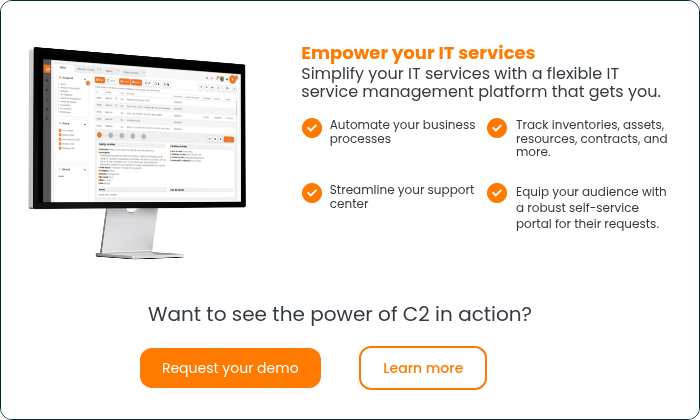IT service management (ITSM) is an organized approach IT teams can take to deliver information technology to their customers. ITSM’s main focus is on packaging the delivery of IT into services.
Instead of just installing a new piece of hardware or troubleshooting a software problem, when you package IT as services, you create complete life cycles within your organization for technology and the workflows in which they’re embedded. This process is typically managed through an ITSM software platform.
ITSM has proven to be an effective management philosophy because its focus on structuring technology into services helps IT teams align what they do with their organization’s overall strategy. Of course, that might also mean that a service management philosophy isn’t even really tied to information technology.
Can you take ITSM beyond the IT department? To answer that question, let’s explore how ITSM methodologies work and some of the many benefits they can offer businesses.
ITSM involves a few core processes
By design, ITSM allows for flexible processes. But most ITSM methodologies, and the software platforms that power them, offer a few key capabilities.
Service request management
ITSM is sometimes mistaken as a way just to conduct troubleshooting and support. While it does much more than that, ITSM does an excellent job of service request management, too.
A service request is any procedure for handling a customer’s needs. ITSM methodologies want service requests to be standardized and repeatable.
IT asset management
Every piece of your organization's hardware, software, license, network or other IT system is an asset. ITSM methodologies want you to track and manage these assets across their entire lifecycle in your organization. You must account for their purchase, deployment, maintenance, upgrades and decommissioning. You should always be able to identify what state an asset is in and how it connects to your other assets at any given time.
Knowledge management
Beyond assets, your organization must also maintain all the collected knowledge about your services, teams, problems and any other management processes on this list. In an ITSM methodology, you’ll have a knowledge base where you create and share this information.
Incident management
Under ITSM, an “incident” is when one of your services is unexpectedly unavailable. Incident management is the ITSM process for identifying the issue and restoring it quickly. ITSM software will provide tools to support this process.
Problem management
Problem management in ITSM is the process of investigating the cause of an incident and mitigating the chance of it reoccurring. A successful problem investigation will likely result in changes to your other processes, such as adding new information to your knowledge base or restructuring how your assets are networked.
Change management
No system ever stays the same. It shouldn’t. You want your IT systems and processes to improve. Change management is the process of improving your ITSM methodology reliably and consistently over time.
ITSM makes IT better
Delivering information technology more effectively is good for your entire organization. It benefits your IT team and everyone else who depends on IT. As we’ve already touched on, ITSM provides many benefits that are not technical. That leads us to some interesting conclusions about using ITSM beyond the IT department for other professional activities.
Some of the key benefits of using ITSM practices include:
Cost savings
Service management practices are designed to standardize and automate work. As a result, they reduce operational and staff performance variability and make service delivery more efficient. You’ll be able to increase your team’s productivity once an ITSM platform can streamline their processes.
Increases operational efficiency
Adopting service management practices will allow your organization to improve its workflows through automation. You’ll also extract maximum value from your managed assets and services.
Improved productivity
ITSM principles establish clear guidelines and metrics for you to measure employee performance. ITSM tools make work more productive because all managed processes are streamlined and automated. Incidents specifically will be better managed. You’ll be able to respond faster to incidents, increasing service uptime to keep your organization running.
Mitigate risk
Organizations following a service management methodology will conduct safer day-to-day operations and perform large-scale changes more effectively with less risk than they would otherwise. Formalized planning, design and implementation procedures make large projects more predictable, transparent and easier to fix when something goes wrong.
Better customer service
It’s right in the name: service management is all about providing better service. It structures how your organization works into processes that give customers exactly what they want every time.
New insights
Service desk software streamlines work processes and collects data end-to-end at each step along the way. That data can provide new insights you might not have been able to generate otherwise. Managers can easily track the progress of any service request or project underway. They’ll be able to identify inefficiencies and easily kick off change requests to eliminate them, all on the same platform.
What this all means: Service management works beyond IT
You might have noticed something about the benefits we described above. None of them are specific to IT. You could apply them as positives for any business unit!
Many business leaders have come to the same realization. If they can restructure any part of their business operations into service delivery, they can improve it using service management best practices, or enterprise service management (ESM).
ESM takes ITSM beyond the IT department. It takes the core ideas from IT service management and applies them to other business teams, like human resources, facilities and vehicle fleet management. And when you use service management software, you can bundle all these departmental services together on the same platform. That will encourage collaboration and provide a range of new benefits across the organization.







